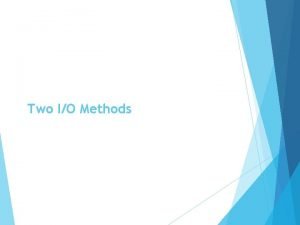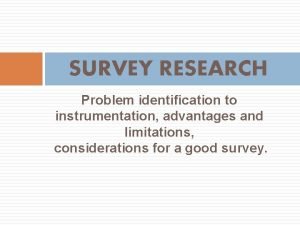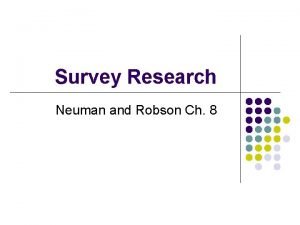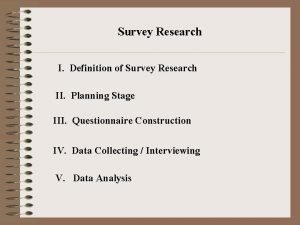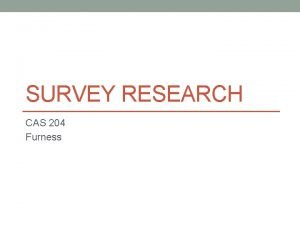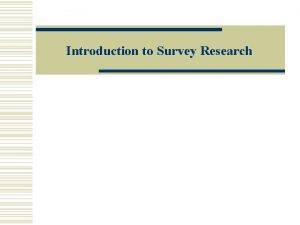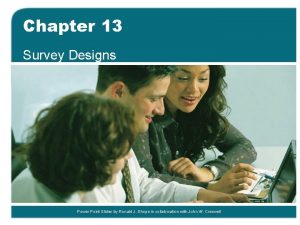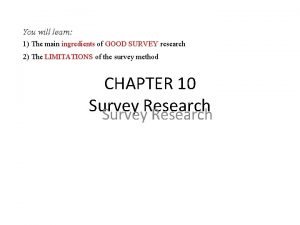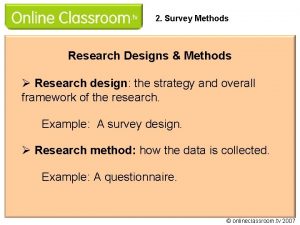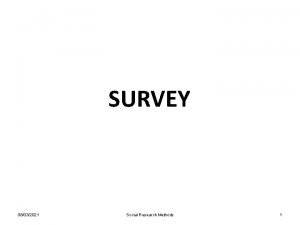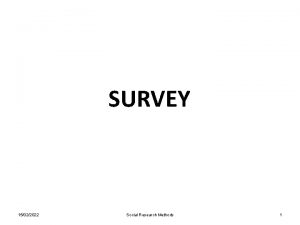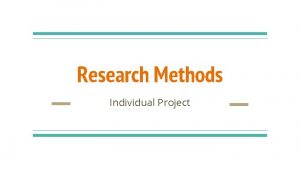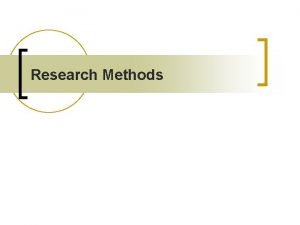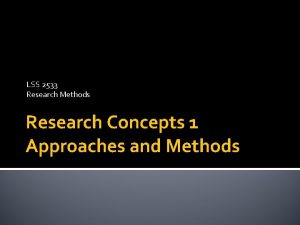RESEARCH METHODS Lecture 20 SURVEY RESEARCH Two approaches
































- Slides: 32

RESEARCH METHODS Lecture 20

SURVEY RESEARCH

Two approaches to collect primary data 1. Observe conditions, behavior, events, people, or processes 2. Communicate with people. �Selected approach determines the research design to be followed.

Communication Approach �Involves surveying people and recording their responses for analysis. �Versatile approach: variety of communication media can be used. �Traditional communication media – Human interactive media. �Modern communication – use of digital technology – Electronic interactive media. �Non-interactive media.

Human Interactive Media �Personal forms of communication. Face to face interaction of individuals and or groups. �Can also be conversation on telephone

Electronic Interactive Media �Use of digital technology to reach people. �Respondents are actively involved. Internet – new electronic interactive media

Non-Interactive Media �Traditional questionnaire received by mail �Self administered questionnaires �Questionnaires delivered through other means – Fax machine, uploading on internet, printing in the newspaper.

Choosing a Communication Media Once decided about doing survey then collect data by using different media: - Personal interviewing - Telephone interviewing - Mail questionnaire - Self-administered questionnaire - Computer assisted medium - Mixed media

Personal Interviewing �Face to face interaction between strangers �Respondent provides information with little hope to receive any immediate or direct benefits. �Personal interview can take place anywhere.

Advantages of Personal Interviewing

1. The opportunity for feedback �Clarify respondent’s apprehensions. Assurance for confidentiality. �Clarify questions asked. Clarify instructions given for responses. �Debriefing

2. Probing Complex Questions Probing implies the verbal prompts made by the interviewer when: �Response is not clear. �Enlargement of the response is needed. �More needed in open ended questions.

3. Length of Interview Compared with other interviews personal interviews can be lengthy, if needed.

4. High Completion Rate �Interviewer to make sure that all applicable questions have been answered. �In telephone, the respondent may just hang up in the middle. �Personally administered questionnaire have high incompletion rate. Respondents don’t want to write long answer for open ended questions. �Item non-response: failure to provide an answer to a question. Low in personal interviewing

5. Props and Visual Aids Can see the new product sample, taste a product and give his/her evaluation. It is not possible for telephone interview or a mail survey.

6. High Participation Rate �The presence of the interviewer increases the % of people to participate. �No reading, no writing – only talking. Share their feelings with friendly and sympathetic interviewers.

7. Observing the Non- Verbal Behavior Interviewer can catch the body language, facial expressions. Observe the environment as well.

8. Non-Literates can Participate Illiterate or functionally illiterate person can take part in the study.

9. Interviewer can Prescreen Respondent �Respondent to fit the sampling criteria. �Interviewer has some control over the environment. �No control in mail survey, telephone interview, or internet interview

10. Computer Assisted Personal Interviewing �Computer Assisted Personal Interviewing (CAPI) – Use of modern technology �Microcomputers can be used for direct entry of responses. Reduces error and cost

Disadvantages of Personal Interviewing

1. High Cost �Geographical proximity, length of questionnaire, No. of recalls – influence cost �Training, supervision, logistical arrangements add to the cost. �Estimates show 15 times higher than mail survey.

2. Scarcity of Highly Trained Interviewers For quality study we need quality interviewers

3. Callbacks –A Labor Intensive Work �Callbacks are attempts to re-contact the missing sample cases. �Labor intensive work – increases cost.

4. Interviewer Influence Demographic characteristics of the interviewer can influence the respondent’s responses.

5. Interviewer Biases in understanding, recording, and interpreting the responses

6. No Opportunity to Consult Interview may take place anywhere – the respondent unable to consult any record or person in case he has to.

7. Less Standardized Wording �Interviewers may make alterations in wording, and sequencing of questions. �Bias the data

8. Limitations of respondents’ availability and accessibility Some executive officers and VIPs are never available or not willing to talk to researchers.

9. Some neighborhoods difficult to visit �Security reasons �Some neighborhoods may not allow outsiders. Some others may be scary for the interviewers.

Door to Door Interviews �Personal interviews at respondent’s home or place of work. �More representative than others. We walk through. Can catch those without phones or having unlisted numbers. �May exclude living in multiple dwellings, high rise buildings, executives. �People who are at home are special type – moms, retired persons

Intercept interviews in shopping mall �Shoppers are interviewed at a central point in the mall or at the entrance. �Low cost. �Incidence of refusal is high. �May not be a representative sample of the population. �Each mall will have its own characteristics. �High traffic areas – some fast food center
 Transport phenomena lecture notes ppt
Transport phenomena lecture notes ppt 01:640:244 lecture notes - lecture 15: plat, idah, farad
01:640:244 lecture notes - lecture 15: plat, idah, farad Teaching approaches
Teaching approaches Ample abcde
Ample abcde Od survey methods
Od survey methods Fabrication of wax pattern
Fabrication of wax pattern Major approaches to corporate governance
Major approaches to corporate governance What are the two types of forecasting
What are the two types of forecasting The two dominant agile approaches are
The two dominant agile approaches are Marketing research approaches to demand estimation
Marketing research approaches to demand estimation Process of research definition
Process of research definition What is quasi experimental research
What is quasi experimental research Research philosophies and approaches
Research philosophies and approaches Research methodology lecture notes doc
Research methodology lecture notes doc To gain familiarity with a phenomenon
To gain familiarity with a phenomenon Dressmakers carbon paper is usually used in this method
Dressmakers carbon paper is usually used in this method Two i/o methods
Two i/o methods Two branches of statistics are
Two branches of statistics are Methods of pasteurization
Methods of pasteurization Research instrument example
Research instrument example Strengths of survey
Strengths of survey What is survey research
What is survey research Conceptual framework for descriptive research
Conceptual framework for descriptive research Descriptive survey
Descriptive survey Advantages of survey research
Advantages of survey research A survey from teenage research unlimited found
A survey from teenage research unlimited found Lit survey
Lit survey Descriptive method research
Descriptive method research Advantages and disadvantages of sample survey
Advantages and disadvantages of sample survey Introduction to a survey
Introduction to a survey Experience survey in exploratory research
Experience survey in exploratory research Characteristics of survey research
Characteristics of survey research Variables in survey research
Variables in survey research
















